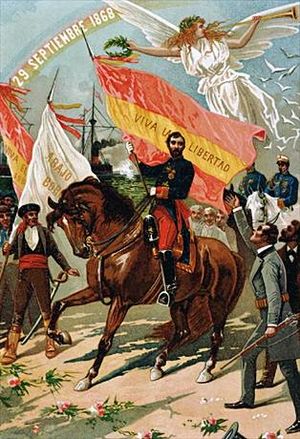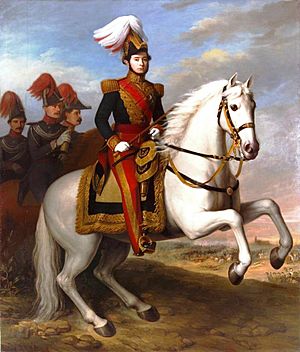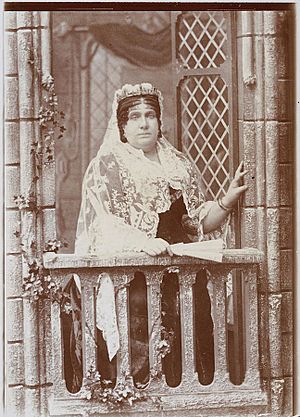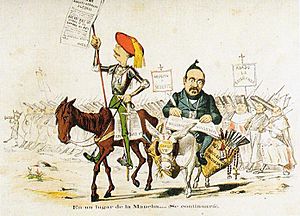Glorious Revolution (Spain) facts for kids
Quick facts for kids Spanish Revolution of 1868Glorious Revolution |
|||||||
|---|---|---|---|---|---|---|---|
 Revolution of 1868 "La Gloriosa", allegorical cartoon of 1874 published in the magazine La Flaca |
|||||||
|
|||||||
| Belligerents | |||||||
|
|
||||||
| Commanders and leaders | |||||||
The Glorious Revolution (also called la Gloriosa or la Septembrina in Spanish) was a big event in Spain in 1868. It led to Queen Isabella II losing her throne. This revolution started a new period in Spanish history called the Sexenio Democrático, which means 'Democratic Six Years.' A temporary government was put in charge.
Why the Revolution Happened
Before the Glorious Revolution, many people in Spain were unhappy with Queen Isabella II. There had been several attempts to remove her from power. These included uprisings in 1854 and 1861.
In 1866, a rebellion led by General Juan Prim and a revolt by soldiers in Madrid showed that many people wanted change. Spanish liberals and republicans living outside Spain started making plans. They met in Ostend in 1866 and Brussels in 1867.
These meetings helped them plan a big uprising. This time, the goal was not just to change the Prime Minister. They wanted to remove Queen Isabella completely. Many people believed she was causing Spain's problems.
By 1868, Queen Isabella had upset many different political groups. These included the moderates, progressives, and members of the Unión Liberal. An opposition group formed that included people from different political parties. When Leopoldo O'Donnell, a key leader, died in 1867, his party, the Unión Liberal, started to fall apart. Many of its members joined the growing movement to overthrow Isabella. They wanted a more effective government for Spain.
The Revolution Begins

In September 1868, naval forces in Cadiz rebelled. They were led by Admiral Juan Bautista Topete. Cadiz was the same city where, about 50 years earlier, Rafael del Riego had started a rebellion against Isabella's father, Ferdinand VII.
When Generals Prim and Francisco Serrano spoke out against the government, many parts of the army joined them. The queen's loyal generals, led by Manuel Pavia, tried to fight back at the Battle of Alcolea. However, General Serrano's forces defeated them.
In 1868, Queen Isabella left Spain and went to France. She lived in exile in Paris until she died in 1904.
What Happened Next

After the revolution, the new leaders faced a big challenge. They needed to create a government that everyone could agree on. Control of the government went to Francisco Serrano, one of the revolution's main leaders.
The Spanish parliament, called the Cortes, first decided not to become a republic. Serrano was made regent, which meant he ruled temporarily. Meanwhile, they started looking for a new king for Spain. In 1869, the Cortes wrote a new liberal constitution. It was the first one in Spain since 1812.
Finding a suitable king was difficult for the Cortes. Many republicans were willing to accept a king if he was good and followed the new constitution. Prim, who had often rebelled against Isabella's governments, became regent in 1869.
Some suggested Isabella's young son Alfonso (who later became Alfonso XII of Spain). However, others worried he would be controlled by his mother. Ferdinand of Saxe-Coburg, a former ruler of nearby Portugal, was also considered. There was also a fear that choosing Prince Leopold of Hohenzollern-Sigmaringen could start a war between France and Prussia.
In August 1870, they chose an Italian prince named Amadeo of Savoy. He was the younger son of Victor Emmanuel II of Italy. Amadeo was a good choice because he didn't have the political problems that a German or French candidate might bring. He was elected King Amadeo I of Spain on November 3, 1870.
He arrived in Cartagena on November 27. Sadly, on the very same day, Juan Prim was assassinated as he left the Cortes. Amadeo promised to uphold Spain's constitution over the general's body.
Amadeo ruled for two years. After that, the political parties formed the first Spanish Republic. This republic also lasted only two years. No political group wanted to bring Isabella back to the throne. Instead, in 1875, the Cortes declared Isabella's son, Alfonso XII, as the new King.
See also
 In Spanish: Revolución de 1868 para niños
In Spanish: Revolución de 1868 para niños




